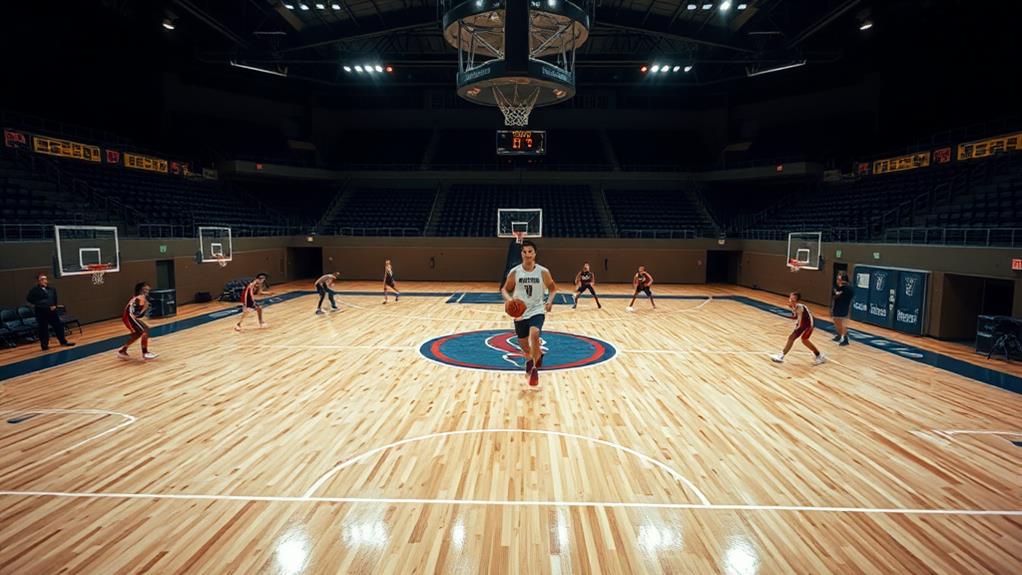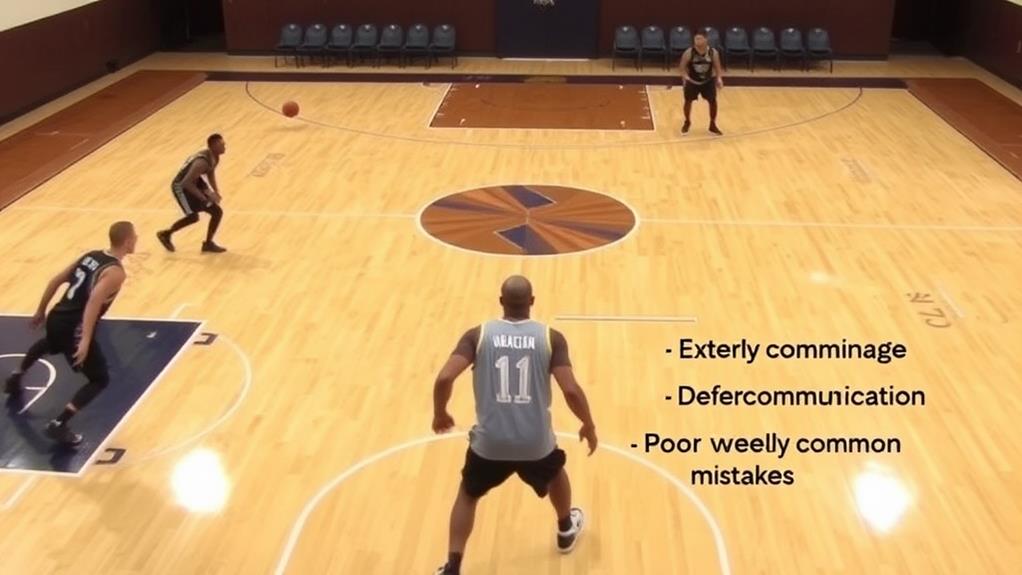
ISO in Basketball: What It Means and When to Use It
September 22, 2024ISO play in basketball is all about creating one-on-one scoring chances by isolating a key offensive player. You use isolation to exploit mismatches and disrupt defensive cohesion, allowing your best scorer to shine. It's particularly effective when the game's tight, like when the score is close. To successfully implement ISO, focus on strong spacing and quick decision-making. Avoid common pitfalls like poor positioning and over-reliance on one player. This strategy not only boosts scoring opportunities but also enhances team dynamics. If you're curious about mastering ISO techniques, you'll find plenty of valuable insights ahead.
Definition of ISO Play
ISO play, often used in basketball, is a strategy that creates one-on-one scoring opportunities by isolating a key offensive player against a defender. This technique allows the offensive player to leverage their skills, often exploiting mismatches against less skilled or smaller defenders.
In an ISO situation, the other offensive players position themselves away from the action, creating space and distractions for the defense. The effectiveness of ISO plays can be enhanced through careful data analysis of player matchups, which helps identify favorable conditions for execution.
Successful ISO plays hinge on strategic spacing across the court, which guarantees that driving lanes are clear for the offensive player. With ample room to maneuver, the offensive player can use quick movements and excellent ball-handling skills to either create their own shot or drive toward the basket. This approach not only maximizes the offensive player's strengths but also puts pressure on the defense to adjust quickly.
ISO plays are particularly effective when a team identifies a defensive weakness or mismatch, making them a critical component of many coaches' offensive strategies. By isolating an offensive player, you can capitalize on favorable matchups, increasing your chances for scoring and keeping the defense on its toes.
Purpose of Isolation Plays
Isolation plays are all about creating scoring opportunities for a specific player, letting you take advantage of any mismatches on the court. When you isolate a player, it not only highlights their strengths but also forces defenders to make quick decisions that can lead to breakdowns.
This strategy can set up easier fast break baskets, catching the defense off-guard as they scramble to recover. Furthermore, with the evolution of defensive strategies, particularly the emphasis on teamwork and communication, isolation plays can disrupt defensive cohesion, making it even more essential to capitalize on favorable matchups.
Scoring Opportunities Creation
Creating scoring opportunities is essential in basketball, and one of the most effective ways to achieve this is through isolation plays. These plays focus on a single offensive player, allowing them to exploit one-on-one matchups while drawing defenders away from the basket. When you run an isolation play, you're not just setting up for your star player; you're also creating space for higher percentage shots.
The setup of isolation can lead to immediate scoring opportunities. By collapsing the defense, especially when there's a strong inside presence, you can open up shooting lanes for teammates. This flexibility allows you to execute isolation plays spontaneously, taking advantage of favorable matchups during the game.
Isolation plays also pave the way for easier scoring opportunities, as breaking down the defense can lead to quick scoring chances right after the play.
As you master the isolation technique, you'll notice how it not only enhances your chances of scoring but also creates a dynamic offensive flow, keeping defenders on their toes and making your team harder to guard.
Ultimately, isolation plays are a key strategy for maximizing scoring opportunities within your game.
Exploiting Defensive Weaknesses
When you focus on maximizing scoring opportunities, exploiting defensive weaknesses becomes a key strategy. Isolation plays are specifically designed to set up one-on-one matchups, allowing your skilled offensive players to capitalize on slower or less skilled defenders.
If you notice an aggressive double team, isolating a player can create open shot opportunities for teammates as defenders collapse, leading to potential scoring chances.
Moreover, an isolation play can effectively draw defenders away from the basket, opening up passing lanes for shooters. This creates easier scoring opportunities, particularly if you have a player with a height or skill advantage over their defender.
By monitoring the opposing team's defensive rotations, you can identify mismatches that make isolation plays even more valuable.
When defenders are out of position, it's your chance to strike. Use these opportunities to take advantage of the weaknesses in their defense, and watch your scoring average rise.
Essentially, isolation plays serve as a powerful tool in your arsenal, enabling you to exploit defensive lapses and maximize your team's offensive potential.
Transition Basket Advantages
How can isolation plays transform your team's shift game? By creating one-on-one opportunities, you can exploit defensive weaknesses, especially against aggressive double teams. This allows your offensive player to capitalize on mismatches, leading to easier changeover baskets.
When you initiate an isolation play, it draws defenders away from the basket, opening up passing lanes for your teammates. If the initial scoring opportunity doesn't pan out, this setup can still facilitate changeover baskets as players move quickly into advantageous positions.
Furthermore, effective isolation plays can lead to quick scoring chances, particularly when the offensive player drives to the basket or creates space for a shot. As the defense commits to help, your team can seize fast break opportunities, enhancing your changeover offense.
This strategy becomes vital during tight game moments, where quick points can shift the momentum in your favor. By strategically using isolation plays, you not only increase scoring efficiency but also keep the defense on its toes, making it harder for them to react.
Embrace isolation plays to maximize your chances of scoring in changeover and elevate your team's overall performance.
Timing for Calling Isolation

Effective timing for calling isolation plays can be a game-changer in basketball. You should look to call an ISO when the score is tied or within single digits. This boosts your chance for quick scoring opportunities and can be essential in tight games.
Isolation plays are also advantageous when you want to avoid second offensive rebounds while keeping your defense aggressive. Additionally, understanding player strengths and weaknesses can enhance your strategy, so utilizing insights from soccer moves guide can also be beneficial for basketball players looking to develop their skills.
Pay attention to the pace of the opposing team; if they play fast, it's an excellent time to strategically position your players. This allows your ball handler to exploit mismatches or defensive lapses. Anticipating how the defense will react to your ball handler's movements is key for execution.
When you decide to call for an isolation play, make sure your players are properly positioned. This positioning directly influences how effectively your team can create scoring chances.
If the timing and positioning are on point, your chances of success increase considerably. Remember, the execution of these plays can define moments in a game, so choosing the right time is essential for seizing control and scoring effectively.
Effective Isolation Strategies
When you implement effective isolation strategies, mastering key techniques is essential for success.
Be mindful of common execution pitfalls that can derail your plays, like poor spacing or mismatched matchups.
Key Isolation Techniques
Isolation techniques can turn the tide in a basketball game, allowing players to capitalize on one-on-one matchups. To maximize your effectiveness, start with strong spacing. This setup creates clear driving lanes for offensive players and opens up opportunities for kick-out passes to teammates.
Crossover dribbles can be especially effective in creating space. By forcing defenders to collapse, you generate scoring chances. Incorporating timely screens can also enhance your isolation plays. A well-placed screen disrupts defensive assignments, providing the offensive player with a favorable mismatch.
To keep the defense guessing, vary your approach. Attack from different angles or use quick hesitation moves to throw off defenders. This unpredictability can lead to additional scoring opportunities.
Common Execution Pitfalls
While mastering isolation techniques can considerably enhance your offensive strategy, there are common pitfalls that can undermine your success on the court. One major issue is failing to maintain proper spacing. When you crowd the floor, it creates congested driving lanes, limiting scoring opportunities for the one player you're isolating.
Off-ball players need to keep moving; if they stay static, the defense will easily predict your actions and may double-team the ball handler.
Another pitfall is over-relying on a single player. This makes your offense one-dimensional, allowing defenders to focus their attention solely on shutting down that player. Effective communication among teammates is vital; without it, players might struggle to execute their roles, leading to confusion and missed opportunities.
To combat these issues, consider incorporating screens or picks before initiating isolation. This strategy can create advantageous matchups and enhance the effectiveness of your play by forcing defenders to make quick decisions.
Execution of ISO Play

Executing an effective ISO play hinges on strategic positioning and proper spacing. You need to create driving lanes for the ball handler, which means off-ball players must position themselves to avoid congestion.
The evolution of offensive strategies, including the rise of isolation plays, highlights the importance of effective execution in modern basketball innovations in offensive strategies. Communication among players is essential; everyone should be on the same page regarding intended movements and potential screens that can assist the ball handler.
Timing is critical in executing an ISO play. Offensive players must move in sync to keep defenders off-balance, enhancing the element of surprise. For instance, off-ball players should engage in subtle movements to draw their defenders away from the primary scorer. This creates more space for the isolation to work effectively.
Using screens can greatly enhance the ISO play. A well-timed screen can temporarily free the ball handler from their defender, opening up easier scoring opportunities.
When executed correctly, these elements come together to maximize the potential of the ISO play, allowing for a more effective offensive strategy. By focusing on positioning, communication, timing, and movement, you can set the stage for a successful isolation and capitalize on scoring chances.
Benefits of ISO Play
One of the standout advantages of ISO play is its ability to simplify offensive strategy, allowing a skilled player to go head-to-head with a defender. This one-on-one dynamic often leads to high-percentage shots, as talented players can leverage their unique skills to exploit defensive weaknesses. When mismatches occur, and a defender is at a disadvantage, you're more likely to be able to score effectively.
Furthermore, utilizing isolation plays can draw attention away from the center position, which is essential since modern centers are expected to stretch the floor and create scoring opportunities for themselves and others, enhancing their impact on the game.
Additionally, ISO play can create open shot opportunities for your teammates. As defenders collapse on the ball handler, passing lanes open up, enabling quick, strategic passes that can lead to easy baskets. This not only boosts your scoring chances but also strengthens team cohesion.
Isolation plays also pull defenders away from the basket, facilitating easier changeover opportunities and creating space for potential shooters. This spacing allows your team to maintain offensive rhythm and find the best shot available.
Ultimately, effective execution of isolation plays encourages you and your teammates to develop individual scoring abilities. This growth enhances overall team performance, making ISO a valuable tool in your offensive arsenal. By understanding these benefits, you can maximize your effectiveness on the court.
Common Mistakes to Avoid

When it comes to isolation plays in basketball, steering clear of common mistakes is crucial for success. One major error is failing to move off-ball. If players run in place, the offense becomes stagnant, allowing defenders to easily predict your moves and limit scoring opportunities.
In basketball, like in soccer, maintaining effective spacing is essential for enhancing offensive flow and creating scoring chances; poor spacing can lead to a disorganized attack, much like a 4-4-2 Classic Formation provides balance in soccer. Over-relying on a single player during isolation can also make your offense one-dimensional, enabling the defense to focus all their efforts on shutting that player down.
Another common mistake is poor spacing among players. When spacing is tight, it creates congestion, limiting driving lanes and making it difficult for the offensive player to maneuver effectively.
Lack of communication between players can lead to confusion, resulting in missed opportunities and ineffective execution of isolation plays.
Strategic Considerations for ISO
Isolation plays demand strategic foresight to maximize their effectiveness on the court. To start, analyze matchups carefully. Identify situations where your player can exploit a defensive player's weaknesses. This insight can make the difference between a successful iso play and a missed opportunity.
Furthermore, it's important to recognize that systemic biases in player development disproportionately affect Black athletes, which can influence how matchups are perceived and executed in games historical discrimination faced by early Black players.
Before initiating an isolation, consider incorporating screens or picks. These moves can create separation, forcing defenders to react and enhancing your chances of scoring. Additionally, utilize ball movement prior to the iso. This tactic can confuse defenders, making it harder for them to anticipate your offensive player's actions.
Monitoring defensive adjustments throughout the game is essential. If the defense changes its strategy, adapt accordingly to maintain an advantage in your iso plays.
In addition, keep an eye on player fatigue and the level of defensive pressure. Fresh players tend to execute iso plays more effectively and can capitalize on any lapses from the defensive player.
Implementing Isolation Techniques

To effectively implement isolation techniques, players must focus on honing their individual skills through dedicated practice. This mirrors the importance of mastering essential skills in soccer, where individual abilities contribute to team success.
In youth basketball, mastering these skills can markedly enhance your game and increase your chances of success during isolation plays.
Here are three key areas to concentrate on:
- Dribbling Skills: Work on diverse moves like crossover dribbles and hesitation moves. This keeps defenders off-balance and creates more scoring opportunities.
- Shooting Accuracy: Devote time to shooting drills, especially under pressure. This guarantees you can make vital shots when the game is on the line.
- Decision-Making: Practice recognizing when to drive, shoot, or pass. Watching game film can help you identify your strengths and weaknesses in isolation situations, allowing for targeted skill development.
Consistent practice in isolation scenarios will also improve your sense of timing and spacing on the court, both of which are fundamental for effective isolation plays.
Conclusion
In the thrilling dance of basketball, mastering the ISO play can feel like a magician's trick—one moment, the court's cluttered, and the next, you've created space for your star to shine. When you call for isolation, envision the crowd holding its breath, the spotlight on you. Embrace the rhythm, execute with precision, and watch as defenders scramble, leaving room for that game-winning shot. With practice, you'll turn those moments into unforgettable highlights, leaving your opponents in the dust.


